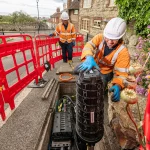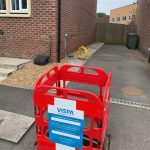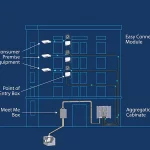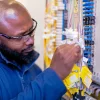ISP BT to Restart Troubled UK Digital Voice Rollout in Spring 2023

Broadband provider BT has issued an update on the national UK rollout of their new Voice-over-Internet-Protocol (VoIP) based Digital Voice product, which was “paused” in May 2022 (here) following complaints about service outages during power cuts etc. But the ISP now says this is “likely” to restart during the “spring of 2023“.
Just to recap. The Digital Voice product was designed to replace their old analogue phone service, which will cease to function once the Public Switched Telephone Network (PSTN) is completely withdrawn by December 2025. After that point, all future phone services, whether delivered via copper (ADSL, FTTC, G.fast) or full fibre (FTTP) based lines, will become IP (internet) based and require a broadband connection to function.
Like it or not, the old analogue voice service is destined for the rubbish bin of history. Part of this relates to the switch to Fibre-to-the-Premises (FTTP) based broadband lines, which work in a completely different way, as well as the inevitable withdrawal of copper lines to follow (i.e. it is not economically viable to retain both). On top of that, very few people today make much use of their landline phone (most prefer mobile, VoIP and internet messaging), which is now considered to be an optional add-on.
Advertisement
Suffice to say, a lot of people will be happy to see the old service go, but that feeling is not universal. Many other consumers often only became aware of the transition, which has been telegraphed for years (see our 2017 article), once they started to be directly impacted by it, and they then quickly discovered some of the well-known caveats.
Firstly, the setup of Digital Voice, and similar IP based voice products from other providers, is a little bit more complicated because you have to plug your handset into a broadband router or ATA adapter instead of the wall socket (more details). On top of that, a lot of old systems designed for the analogue phone service (e.g. home alarms, remote medical monitoring etc.) don’t function with IP based lines and need to be upgraded.
However, the loudest gripes came from those – particularly vulnerable consumers and landline-only phone users – who quickly discovered that IP based phone services tend to fail in a power cut as they can’t be remotely powered. In order to resolve this, ISPs need to deploy Battery Backup Solutions for your handset, router and ONT (the latter is only relevant if you have FTTP), but these will only last for an hour or a little more. Hard luck if you need to call 999 in an area with no mobile signal, during a protracted power outage.
BT Takes the Flak
As the largest UK player in the transition to IP based phone services and the one with the highest proportion of landline-only customers, BT’s Digital Voice transition ultimately ended up taking most of the flak – perhaps unfairly (it’s an industry-wide change) – for the service’s aforementioned caveats.
Advertisement
The problems were underlined again earlier this year after a series of violent storms swept the country and caused various protracted power cuts, which hit many early adopters of their Digital Voice product. BT responded to all the negative stories about its Digital Voice transition by choosing to pause part of the migration process, while admitting that it made a mistake and promising to make a series of changes (we’ve summarised them below).
BT’s Planned Digital Voice Changes
➤ Hybrid phones that can switch to a mobile network and have an in-built, long-lasting battery.
➤ The option of longer-lasting battery back-up units for customers who want or need them.
➤ Providing in-home ‘mobile landlines’ for people without broadband.
➤ Addressing so-called mobile ‘not-spots’, with continued investment in the Shared Rural Network. In the past 12 months, we’ve improved mobile coverage in more than 500 areas across the UK. And we expect to extend coverage in a further 900 locations by 2024.
➤ Raising awareness so that our customers better understand the need to switch.
➤ Continuing to proactively engage related industries – such as healthcare pendant and burglar alarm providers to ensure our most vulnerable customers continue to get the service they need.
➤ We’re continuing to work on other things, too – including advancements to scam-call shielding and fraud reduction tools, which we know are becoming ever more important to our landline users.
The latest update from Nick Lane, MD Customer Services at BT Consumer, reiterates much of what they first announced back in May 2022, but also highlights how they’ve appointed Lucy Baker to lead the huge body of work to move customers’ landlines onto the new digital technology and, critically, “to make sure we get things right for our customers.” Lucy has since setup the Digital Voice Advisory Group to oversee all this.
Nick Lane said:
“This group of key stakeholders has been indispensable in helping to shape our plans for when we come to restart switching customers to digital later in 2023. Specifically, we’ve consulted them on how best to create awareness among customers so they understand why they need to switch, what they need to do, and how to speak to us if they have any concerns.
We’ve been testing this approach with customers in Salisbury and Mildenhall, who will be among the first in the UK to benefit from the changeover to digital phone lines as part of our pilot schemes. Lucy has taken her team and their information bus into town to speak directly to customers, as well as any friends and family who wanted to find out more about the switch and raise any concerns.
Taking the time to listen to our customers and having experts on hand to help has been a great success. We plan to take this approach when we are ready to restart the rollout.”
Nick added that they were now “likely” to restart the rollout during “the spring of 2023” (previously we’d been told that it could begin by the end of 2022 or early 2023), but they plan to contact affected customers “ahead of time and give you the opportunity to raise any concerns with us.” The operator has about 10 million customers to migrate by the end of 2025, although it’s unclear how many they’ve already managed to switch.
However, the reality is that BT – or indeed any ISP – can only do so much on this front to cover for power outages and other issues, while at the same time needing to keep the transition both affordable and practical to deploy. As we’ve said above, this is an industry-wide change and, in fairness, BT has done more than most to tackle the concerns. But we suspect that the inherent realities of this will see ISPs continuing to face criticism, no matter what they do.
Advertisement
Nevertheless, no amount of criticism will reverse the move away from older copper and analogue phone services, which is simply an unavoidable reality of how modern digital infrastructure is evolving.
Mark is a professional technology writer, IT consultant and computer engineer from Dorset (England), he also founded ISPreview in 1999 and enjoys analysing the latest telecoms and broadband developments. Find me on X (Twitter), Mastodon, Facebook, BlueSky, Threads.net and Linkedin.
« Full Fibre ISP Fibrus Makes Progress on Transition to EV Fleet






















































Once again I’m not sure why there was a furore in the first place, because these days apart from the fact that landlines are less popular than before, many of the users of landlines will be using cordless phones which never work in a power cut anyway. So basically surely the only people who would be affected is a very tiny minority, who could easily have solutions in place for that once-in-a-lifetime event?
I can safely say that everyone I know hereabouts keeps a wired phone to plug in for the inevitable weather-related extended power cuts.
While I have disconnected the phone from my landline now, I did have a wired phone on it for a couple of years, openreach used to have a battery backup on their ONT, but took that off, more to do with a money saving thing, not sure what good that would do anyway if there is no battery back up for the router.
What people must remember is that some people who live in the sticks don’t get a good mobile signal, the other thing is a mobile phone don’t send as far as I know any location info back to the emergency services, where a home phone would normally send a phone number and the address can be traced that way.
I know of someone who was saved because of that, they phone for an ambulance, and before they could give their address they passed out, their phone number was used to get the ambulance to them.
Openreach don’t care about that, all they care about is how much money they can make for their shareholders. Should never have been sold off.
“openreach used to have a battery backup on their ONT, but took that off, more to do with a money saving thing, not sure what good that would do anyway if there is no battery back up for the router.”
It did not need to power the router.
The Openreach battery backup unit was provided with ONT’s with a telephone (ATA) port.
These did NOT need a router to make a call.
They used Openreach’s now defunct FVA (fibre voice access) service which terminated in the exchange just like PSTN.
There is a system called Advanced Mobile Location, which works with modern smartphones.
When you call the emergency services from an AML enabled phone (iPhones running iOS 11.3 or later, Android 2.3.7 or later), your phone sends them current location and location accuracy data automatically – sending a location as soon as it’s confident it’s accurate to within 1 metre, or after 20 seconds if it can’t get an accurate location. It also turns on GNSS, and tries to get the most accurate location it can.
To get a sense of how accurate the location data is, fire up Google Maps or similar app, and look at the blue circle over time – it’ll start out wildly inaccurate (with a big circle around the location), and become more accurate quite quickly.
Anybody else see the shortcomings with Advanced Mobile Location, which works with modern smartphones.
Of course, I fully understand the reasons for this but there is something seriously wrong with our technology development and implementation when a dramatic decrease in resilience – and, make no mistake, this is a dramatic decrease, especially in rural areas, with only limited mitigations – is a consequence.
Going to dust off my genny and my ham radio equipment for the inevitable, to provide some support to my community….
Yep, agree 100%
To add to my post o that I agree, this is the same with the pushing to a cashless society
What do FTTP customers do?
Future unavailability of a reliable 50v supply from the exchange is inevitable I suppose. However in Storm Arwen hundreds of people were without power for a week. The continued functioning of a landline phone was very useful for those who were affected. Reliability and resilience of critical national infrastructure should be led by government. They should be dictating contingencies and minimum requirements . It may be that with changing telecoms technology, a requirement should be placed on power companies rather than communications companies to improve resilience.
Difficult to know what you can do to improve power supply resilience in areas with 11KV overhead feed. Putting it underground and/or having backfeed capability as modern urban supply has is going to be prohibitively expensive. Batteries and inverters with load management is probably the answer, but again that’s expensive unless it forms part of a solar installation.
On a semi-related note, does anyone have any recommended ATA adapters? Been having issues with my current setup recently (old SPA 3000 and FreePBX) and I’m considering trying an alternative.
My Grandstream HT801 is rock solid.
@Bubbles DeVere
Thanks I’ll look into them.
Yup, the HT801 is the one we supply to our VoIP customers too. The gui is clunky, to say the least, but the device has been rock solid for us so far.
Thumbsup from another HT801 user. I’d imagine this sort of ATA tech could run off a reasonably sized battery (eg. Ring camera-type) for many hours.
I have had nothing but trouble with my BT digital voice line since I upgraded to FTTP.
Calls will randomly disconnect but the router and Ont stay fully live, I have had two lots of BT staff investigating the issue as well as Openreach engineers checking the line and some equipment in the exchange.
Unfortunately nothing has been able to resolve it and even though the Copper line is still active with a dial tone they will not allow me to switch back
Does the line with the dial tone work? I wouldn’t expect a dial tone if it’d been cut over correctly, though may be wrong.
Dial 17070 to find out.
If there’s dialtone, it will work for emergency calls. But it could be disconnected at any time, i.e. the port could be reassigned to another user.
People who rent a security pendant or similar telemonitoring with a monitoring service should be able to get a replacement unit from their monitoring supplier that connects with mobile signal and battery backup. This should be available without an increase in monthly monitoring price
I managed to sort one of these out for a relative a couple of years ago; the embedded mobile SIM was a special “all networks” SIM card. The unit was branded Doro, and had capability to add on various wireless and wired sensors although the monitoring service only supported a basic pendant.
I suspect that monitored alarm services can perform a similar swapout.
That said. I understand why there is a desire to get rid of analogue call service, but Openreach could leave 50V power in place to supply backup power to equipment in the customer premises (including an emergency speakerphone/analog phone socket), especially as the initial transition to Digital Voice is presumably low speed ADSL/FTTC so the copper line will still be in place anyway.
Openreach dont supply copper to new sites so no 50v. What would you pay for this when a UPS would achieve the same?
Actually on a long run its nowhere near 50volts, and as for powering equipment, I would suggest the current available is rather low.
You have to add the area code you’re dialling to a local number as well, one step forward, 2 back!
This doesn’t have to be the case. There is no reason the VoIP ATA or phone can not be programmed to dial the code automatically and emulate calling a local number. My Yealink VoIP does this, if it sees a six digit number, it automatically prefixes it with the area code of my preference, so I can still dial a local number, and this can be used to help those people that still dial manual numbers and will be used to just dialing the number only. Of course many people probably don’t dial numbers any more, it’s all done from contact lists.
I was one of the early adopters of Digital Voice and was acutely aware of the problems of “no volts, no phone” being in an area which has frequent power cuts in the winter months. ( A short lived one last night). Also I live in an area where mobile signals are very poor to non existent.
The reason for going digital was two fold – our wired broadband and phone services were very poor due to old wiring in places that often flood.
Ofcom had already made recommendations to all Communications Providers that they should provide BBUs to those in vunerable circumstances. Given our age group and the above problems that was us.
I contacted BT and was told I could have the two BBUs. However it was a protacted fight to get them to actually delivered and only as a result of intervention by our local MSP and the Ombudsman did I get them. BT/Openreach didn’t have the units but they were on sale in the BT shop. I had to buy them myself and BT refunded me. Shortly after getting them I received three more BBUs and a Wifi Disc – non of which I asked for.
The BBUs have already proved their worth in lengthy power cuts.
The Digital Voice service itself is very good, and I particularly like the Call Diversion feature and ability to make and receive and receive two calls at once.
On a seperate note I now have a mobile phone service that can use Wifi Calling.
what kind of nonsense is that? are you keeping your fridge and other devices under ups power all the time? ups you would need for your phone and router would be very small compared to running fridge for same amount of time…
I personally think this should only happen when you go FTTP. I don’t see the point of forcing FTTC customers to go digital voice. The technology is not ready, I like the ideas they have come up with but I am very rural, when we have power cuts the mobile network goes down with it. I don’t want to have to pay £80 for a UPS. should come with the service in my opinion.
The reason it is everyone is because the telephone exchange equipment is now very old and parts are not easy to come by. There isn’t enough money in landlines to justify replacing the exchange kit with something new, and I suspect there is no replacement for analogue land line switched exchange equipment.
Obviously money and profit is a large part of it, if they can get rid of the telephone kit, they will be able to save costs on renting the exchange buildings and all the associate costs that come with running buildings of kit.
I quite agree more needs to be done to ensure people have backup solutions in place. Whilst there are issues with power cuts, I also wonder just how well VoIP would work during any sort of national emergency. What capacity for example has BT employed for VoIP calls? Could all or a large percentage of their customers use their phone at the same time and still have it work? Or is capacity based on very low numbers using the system with little resilience?
What do customers of Virgin Media, Cityfibre, Truespeed, B4RN, Hyperoptic etc. do?
VM no longer provides landline via telephone wires to new customers and those doing house moves, instead the existing handset is plugged into the hub’s TEL 1 RJ11 socket via an RJ11 to BT adapter. Current customers are being migrated as well so that PSTN can be switched off at the end of 2025. So, voice is carried on the same cables with everything else such as broadband and video, and upstream of the cabinets there are IP voice switches instead of TDM switches.
It should be noted that VoIP phones cannot be plugged into the hub and that VM’s IP Voice product and devices such as Telecare alarms will not work in a local power or network outage.
Hyperoptic provide Battery Backup Units (BBU) free of charge to users that require them, providing about 1 hour of power to the Hyperoptic Hub during a localised power cut (ie. loss of power in an individual property).
However in my apartment building with fibre switches in the basement, once the entire building loses power (area power cut) then a BBU will be of no use whatsoever.
To the best of my knowledge the basement fibre switches do not have any battery backup…
I have mine hooked up to a UPS. Even that will realistically only last up to an hour, though – perhaps more if I am around and can shut down the micro-server that also uses it (and is the main reason I have the setup at all). 99.9% of subscribers will not have such a setup. I doubt most of those who need it will have battery backups, either, judging by the above comments. Perhaps the plan is that if they can’t phone in, they can’t claim compensation?
Who will foot the bill for when a vulnerable person dies or gets seriously hurt because of this technology
Same as B4RN etc. customers.
Whoever is responsible for their care and wellbeing.
I’d be more concerned about the regular failing of ambulance response times than infrequent Power outages.
The easiest solution is to offer a mobile phone, with a microcell plugged into the ONT or Router, and a phone charging unit the phone sits in when not in use. They could offer various packages ranging from an all singing all dancing smartphone package, to a basic mobile handset designed for older people, or mobiles with accessibility apps for disabled people. Everything they need is already supplied on mobile handsets, they just need to design packages around current technology.
I don’t understand why they didn’t supply hybrid mobile/voip solutions from the start.
I would like to see microcell & picocells that anybody could buy and were operable with all mobile networks.
I know products like these were available largely before WiFi calling but they were severely limited by the network exclusivity i.e. EE Picocells only worked with EE SIM cards etc.
In my opinion Telet (the 5th MNO) would best be positioned to enable something like as they openly roam already with the other 4 networks – but it would take a bit of consumer interest. Such as in cases of a picocell connected to a ONT & UPS.
“In my opinion Telet (the 5th MNO) would best be positioned to enable something like as they openly roam already with the other 4 networks – but it would take a bit of consumer interest. Such as in cases of a picocell connected to a ONT & UPS.”
If you’re using a mobile with a good battery life, you wouldn’t need a UPS for a basic home phone service, the phone would simply use the nearest local cell tower in the event of a power cut. It opens up other possibilities too, if there’s sufficient bandwidth on the Pico/Microcell, a portion of the bandwidth could be allocated to the home user in a secure dedicated VLAN, with excess bandwidth allocated for users nearby, as long as it’s allowed on the device.
Although I’ve never used a picocell for home use, I used to work in a building with poor mobile coverage and service was provided over such a device, connected via an adsl line running at around 2mb. The phones had to be registered on the device and only available to workers based in the building.
During the storm we had no electricity and no mobile coverage for several days, so mobile is not the solution.
Most sites don’t have generator backup
About time Ofcom did their job properly and mandated that the VOIP telephone can be plugged into any router a customer may have for FTTP not insist on the ISP’s P.O.S.
BT and maybe some others will use the landline wherever possible as an excuse to tie you into their ISP, and SIP providers that are free are next to nil these days. SIPGATE not taking any new customers, charges ahead next year for existing and Draytel VOIP went business only. Also many SIP providers for consumer don’t encrypt.
and I meant a VOIP phone like Siemens Gigaset. I should be able to plug that into my FTTP router (if I was on Openreach FTTP network) and be able to configure the phone to login to Bt’s service for example.
Indeed. We repeatedly asked for the three configuration parameters, but BT either refused and / or just never sent them. Most of our numbers ported to or obtained from Voipfone anyway.
I think it’s about time that people took responsibility for their own safety. If they are concerned about redundancy they should have two communication devices. Most families do. The telcos are not charities, they are there to make money just like any other business. My opinion will cause offence to some people but this is the 21st century. This is no different to the switch from analogue radio and TV – people complained about that too. The internet is here to stay. Some of the comments about security and capacity are relevant but both will improve over time.
I have the digital voice phone and I have to say I am on my third one already. The first one had problems receiving calls, the second one wouldn’t update even when forced to update by BT and the third one is acting like the second one. I get a message that says that there is a update that can’t be downloaded and will download later, but never does. Even if I go into the settings and try a manual update, it is saying that the software is up-to-date. If there is a software update for the digital voice phone, then it should automatically update no matter what. My mobile phone notifies me when there is an update to down, so why can’t these digital phones not do that. Also with this third phone their software stopped my voicemail and it was sending me to BT business and wouldn’t let people who phoned me to leave a message and send them to BT Business. It took them 3 weeks to get the software issue sorted out and was going to send even an engineer out which couldn’t do anything. Also I would like to know where my voicemails were going to because the BT business software was diverting them to a different phone number that wasn’t mine, so that could be seen as a breach of the data protection act as well.
Earlier this year our rural village was hit by a major electricity power cut that lasted 5 days and destroyed a lot of villagers’ power-based equipment such as dish washers, microwaves, TVs, computers and phone systems. As this event was not planned most people did not have all of their mobile equipment charged up and were soon unable to make calls.
At the time I was in hospital having just suffered a heart attack and my partner was as you can expect, keen to be in contact with the hospital. Luckily, we still have copper lines and she was able to use a 25-year-old handset to make and receive calls. We soon became the envy of the village!
For an industry that loves anachronisms, it is what I call it a CIAMS (Criminally insane and mentally stupid) plan. In the above situation a reliance on mobile/ Wi-fi technology we would have been what is technically described as “buggered.”
For the last decade unelected County Council officials have wanted to and successfully closed local libraries. Now I find they have all have been be ‘repurposed’ as centres where people can come and get out of the cold. Before this year nobody in this country was aware of the concept of ‘power warfare,’ where the enemy deliberately takes out all the electricity generating in a country. Whilst old copper lines would suffer in war, the history of WWII shows that this country survived with this method of communication. The question is how long will a mobile phone last on one charge? Communication satellites can be destroyed even quicker than a North Korean/Russian hacker can type his name.
What we need instead is a complete halt and a proper debate about communications in the UK, with public involved rather than a ‘halfwit’ plan pushed forward by the UK’s largest and monopolist company that ultimately is more focused by how much it can increase the CEO’s salary.
I live in a rural location. 20 odd years ago we ended up with no power for three weeks with snow on the ground. Luckily we had a lot of wood to burn… Quite a few neighbours went cold… The local exchange went down sometime during those 3 weeks…
So now almost all electronic devices are plugged into surge protection devices.
I also now have several over sized UPSs to keep mobiles, laptop and router powered.
I always have at least two weeks of chopped wood for heating. And I’ve a gas BBQ.
I also have a portable battery and solar panel for camping (run a youth group and need to stay in contact).
I normally have 30 odd power issues a year (solar panel monitoring equipment logs problems).
Not a monopoly. Hundreds of alternatives.
Oh dear BT have indeed messed up with Digital Line. We ordered BT Classic in early May, but got Digital Line resulting in months of trouble in particular with the dysfunctional Cloud Voice Express App’ on mobile phones (BT also messed up a migration to BT Business Mobile). Mostly working now and nearly £500 compo’, but we would rather have done without all the grief.
Simple answer, provide all mobile phone mast sites with a UPS system that would last a minimum of a week.
You would either need lots of batteries, which would probably be nicked (like the tow rags do to dslam’s) or a generator (where they would knick the fuel and the generator if they could)
Possibly when 5G gets rolled out properly, battery backups in lampposts may work, (though they may knick the lamppost but as they saw through the cable they would hopefully get frazzled)
In a power cut block all calls except emergency calls to conserver power
Has EE indicated when it will begin transferring their landline customers
to digital voice
I received a list of proposed dates that Virgin Media plan to switch over their exchanges to digital. The first exchange is LE1 (I assume this is Lewisham in London) which covers Bexley, Bromley, Greenwich, Lambeth, Lewisham, Merton Southwark & Wandsworth.
This is planned for 1 February 2023. The list appears to be only included their on-net services, i.e. those provided exclusively over VM’s infrastructure and not over Openreach infrastructure. Good luck to customers in those areas.
There is a very good document on the Ofcom website that covers how things have been going at Salisbury and Mildenhall. My take is that people have become very blasé about technology and how easy it is to use and set up (plug and play). This has resulted in those in these two areas not reading the information given to them and thinking it is just an upgrade, not a move to another service that requires actions from them.
https://www.ofcom.org.uk/__data/assets/pdf_file/0020/244136/research-migration-to-voip-openreach-trials.pdf
Around where I live, weather related power cuts can last for several days. Where do you charge your mobile then to use in an emergency, like calling 999?